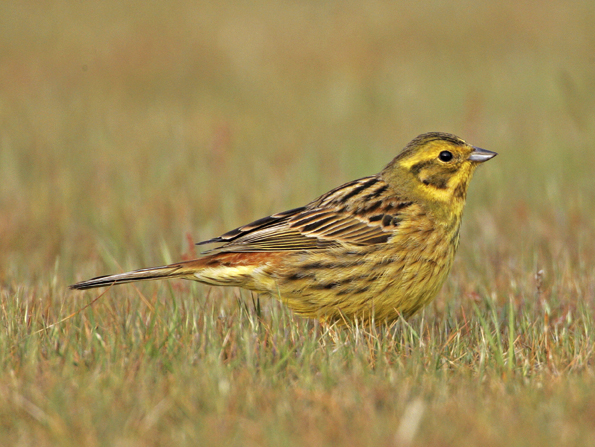Most birders visiting the West Country are keen to see Cirl Bunting, a local speciality, and the males are more readily separable from its close congener, the commoner Yellowhammer. But as birds begin to fledge in mid to late summer, the much trickier non-male plumages are more evident, and birders struggle to say with confidence that they have seen Cirl Bunting.
Both species are almost identical in shape and size, and the convex edge of the grey lower mandible gives them a ‘thoughtful’ expression. Juveniles and females are streaky affairs, with rufous tinges to the secondaries and greater coverts and facial banding composed of a submoustachial stripe and stronger coloration to the lower and upper borders of the ear coverts. These are usually much stronger in Cirl Bunting, which also has finer streaking to the underparts reaching right to the end of the undertail feathers.
Yellowhammer has thicker underpart streaking, often having an unstreaked belly and vent, particularly in the juvenile. The streaking on the scapulars, mantle and back is also thicker on Yellowhammer, and this peters out into a bright rufous rump in typical females; this condition is paler but still notable in juveniles. Cirl has a dirty olive-grey rump.
Wing detail includes white-edged median coverts in Cirl – pale buff in Yellowhammer – and less contrasting brown greater coverts. The head is less streaked on Cirl than in Yellowhammer, which sometimes shows a yellowish central crown stripe. In fact most Yellowhammers will show a yellowish tinge to some or all of the belly, head, throat and rear of the ear coverts, though female Cirl also shows a yellow belly in mature individuals. A juvenile Cirl’s rufous scapulars also contrast more with its greyish upperparts.
So, in the majority of individuals, a greyish rump, fine streaking, strong head pattern and rufous scapulars will indicate Cirl, with more drab, greyer individuals with no yellow on the belly or face likely to be juvenile.

Female Yellowhammer (Sutton Heath, Suffolk, 29 April 2007). Note the more boldly marked head and and wings, and rufous tones to the rump. Photo by Bill Baston (www.billbaston.com).
.jpg)
Female Cirl Bunting (Broadsands Bay, Devon, 22 January 2011). The olive-grey rump is the stand-out feature on this bird. Photo by Richard Bayldon.



